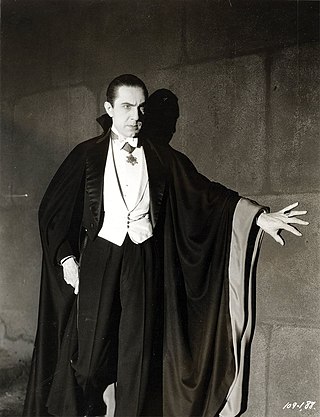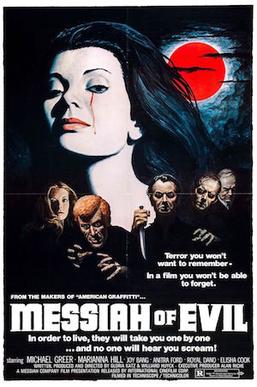Related Research Articles

A vampire is a mythical creature that subsists by feeding on the vital essence of the living. In European folklore, vampires are undead creatures that often visited loved ones and caused mischief or deaths in the neighbourhoods which they inhabited while they were alive. They wore shrouds and were often described as bloated and of ruddy or dark countenance, markedly different from today's gaunt, pale vampire which dates from the early 19th century. Vampiric entities have been recorded in cultures around the world; the term vampire was popularized in Western Europe after reports of an 18th-century mass hysteria of a pre-existing folk belief in Southeastern and Eastern Europe that in some cases resulted in corpses being staked and people being accused of vampirism. Local variants in Southeastern Europe were also known by different names, such as shtriga in Albania, vrykolakas in Greece and strigoi in Romania.

Vampire literature covers the spectrum of literary work concerned principally with the subject of vampires. The literary vampire first appeared in 18th-century poetry, before becoming one of the stock figures of gothic fiction with the publication of Polidori's The Vampyre (1819), which was inspired by the life and legend of Lord Byron. Later influential works include the penny dreadful Varney the Vampire (1847); Sheridan Le Fanu's tale of a lesbian vampire, Carmilla (1872), and the most well known: Bram Stoker's Dracula (1897). Some authors created a more "sympathetic vampire", with Varney being the first, and Anne Rice's 1976 novel Interview with the Vampire as a more recent example.
Strigoi in Slavic mythology are troubled spirits that are said to have risen from the grave. They are attributed with the abilities to transform into an animal, become invisible, and to gain vitality from the blood of their victims. Bram Stoker's Dracula has become the modern interpretation of the Strigoi through their historic links with vampirism.

The Vampire Chronicles is a series of gothic horror novels and a media franchise, created by American writer Anne Rice, that revolves around the fictional character Lestat de Lioncourt, a French nobleman turned into a vampire in the 18th century.

Morbius the Living Vampire, real name Michael Morbius, M.D., Ph.D., is a fictional character appearing in American comic books published by Marvel Comics. Created by writer Roy Thomas and originally designed by penciler Gil Kane, he debuted as a tragic, sympathetic adversary of the superhero Spider-Man in The Amazing Spider-Man #101. For years, Morbius frequently clashed with Spider-Man and other superheroes while occasionally regaining his reason and helping those he regarded as allies. The 1992 Marvel Comics "Rise of the Midnight Sons" crossover event then revived and revised several horror-themed Marvel characters in order to present them as lead protagonists in new titles. The event launched the new series Morbius the Living Vampire, which ran from 1992 to 1995 and now presented the title character as a lethal anti-hero and vigilante. After the cancellation of this series, various stories shifted back and forth between portraying Morbius as a conflicted and brutal anti-hero or a tragic character subject to episodes of madness and murder.
The Churel, also spelled as Charail, Churreyl, Chudail, Chudel, Chuṛail, Cuḍail or Cuḍel is a mythical or legendary creature resembling a woman, which may be a demoniacal revenant said to occur in South Asia and Southeast Asia, particularly popular in India, Bangladesh, Nepal and Pakistan. The churel is typically described as "the ghost of an unpurified living thing", but because she is often said to latch on to trees, she is also called a tree-spirit. According to some legends, a woman who dies during childbirth or pregnancy or from suffering at the hands of her in-laws will come back as a revenant churel for revenge, particularly targeting the males in her family.

Lucy Westenra is a fictional character in the 1897 novel Dracula by Bram Stoker. The 19-year-old daughter of a wealthy family, she is Mina Murray's best friend and Count Dracula's first English victim. She subsequently transforms into a vampire and is eventually destroyed.
In the Anita Blake: Vampire Hunter series of novels, author Laurell K. Hamilton has developed a detailed mythology. Her series is an alternate historyin which the supernatural is real, and vampires, lycanthropes, and other supernatural beings live alongside humans in a society that otherwise resembles 21st century North America.
In the Dungeons & Dragons fantasy role-playing game, a vampire is an undead creature. A humanoid or monstrous humanoid creature can become a vampire, and looks as it did in life, with pale skin, haunting red eyes, and a feral cast to its features. A new vampire is created when another vampire drains the life out of a living creature. Its depiction is related to those in the 1930s and 1940s Hollywood Dracula and monster movies. In writing vampires into the game, as with other creatures arising in folklore, the authors had to consider what elements arising in more recent popular culture should be incorporated into their description and characteristics.

Blood Alone is a Japanese manga series written by Masayuki Takano, author of Boogiepop Dual. It was originally published as a dōjinshi. The manga ended abruptly in Spring 2014, however the story was concluded in a dōjinshi.

Count Dracula is the title character of Bram Stoker's 1897 gothic horror novel Dracula. He is considered the prototypical and archetypal vampire in subsequent works of fiction. Aspects of the character are believed by some to have been inspired by the 15th-century Wallachian Prince Vlad the Impaler, who was also known as Dracula, and by Sir Henry Irving, an actor for whom Stoker was a personal assistant.
The soucouyant or soucriant in Dominica, St. Lucian, Trinidadian, Guadeloupean folklore in Haiti, Louisiana, Grenada and elsewhere in the Caribbean or Ole-Higue in Guyana, Belize and Jamaica or Asema in Suriname), in The Bahamas and Barbados it is known as Hag. It is a kind of blood-sucking hag.

Messiah of Evil is a 1973 American supernatural horror film co-written, co-produced, and co-directed by Willard Huyck and Gloria Katz, and starring Marianna Hill, Michael Greer, Anitra Ford, Royal Dano, and Elisha Cook Jr. Its plot follows a woman who travels to a remote coastal town in California to find her missing artist father; upon arrival, she finds herself in the midst of a series of bizarre incidents.
The Hollows series is a series of 16 urban fantasy novels, eight short stories, two graphic novels, and one compendium resource by Kim Harrison, published by HarperCollins Publishers, in an alternate history universe and set primarily in the city of Cincinnati and its suburbs. The alternate history is built upon two premises: the recent open existence of magical and supernatural species, primarily witches, vampires, and werewolves, with the human population; and the historical investment of Cold War military spending in genetic engineering as opposed to the Space Race, which resulted in the accidental release of a genetically modified tomato in the 1960s that killed a significant portion of the human population. The series is set approximately 40 years after this plague, referred to as ”The Turn“ within the series.

Legends of vampires have existed for millennia; cultures such as the Mesopotamians, Hebrews, ancient Greeks, and Romans had tales of demonic entities and blood-drinking spirits which are considered precursors to modern vampires. Despite the occurrence of vampire-like creatures in these ancient civilizations, the folklore for the entity known today as the vampire originates almost exclusively from early 18th-century Southeastern Europe, particularly Transylvania, Romania as verbal traditions of many ethnic groups of the region were recorded and published. In most cases, vampires are revenants of evil beings, suicide victims, or witches, but can also be created by a malevolent spirit possessing a corpse or a living person being bitten by a vampire themselves. Belief in such legends became so rife that in some areas it caused mass hysteria and even public executions of people believed to be vampires.
The Morganville Vampires is a series of young adult urban fantasy/vampire novels written by Rachel Caine. The novels feature Claire Danvers, a student at Texas Prairie University, and her housemates in the vampire-controlled city of Morganville, Texas. While the mayor of Morganville is human, the population co-exist with a group of vampires. Morganville is also home to an unusually large number of second-hand thrift stores.
Estries are female vampires of Jewish folklore that were believed to prey on Hebrew citizens. The name derives from the French strix, a term for a night owl. In some accounts they are considered identical with succubi: both were portrayed as beautiful, blood-thirsty female demons, with succubi thought to favor babies and young children as prey. Estries, like other vampires, needed to feed on blood to survive and were more indiscriminate in their choice of victims. Succubi were said to kill pregnant women and babies out of jealousy or spite, and to seduce men. Estries and succubi were both said to be able to appear as humans or in spirit form at will, but Estries were also described as able to turn into birds or cats and various other animals.

Curse of the Undead is a 1959 American horror Western film directed by Edward Dein and starring Eric Fleming, Michael Pate and Kathleen Crowley.
Daayan, Ḍāin or Ḍāini is often mistakenly regarded as a rendering for a witch in Indian folklore, the term has been derived from the Sanskrit word dakini, which refers to a female paranormal entity from patala. Dakinis have been described in medieval Hindu texts such as the Bhagavata Purana, Brahma Purana, Markandeya Purana and Kathasaritsagara as female fiendish spirits in the train of Kali who feed on human flesh.

Upiór is a demonic being from Slavic folklore, a prototype of the vampire.
References
- 1 2 3 4 5 6 Melton, J. Gordon (1999). The Vampire Book: The Encyclopedia of the Undead. Visible Ink Press. p. 372. ISBN 978-1-57859-281-4.
- 1 2 3 Bane, Theresa (2010). "Chedipe". Encyclopedia of Vampire Mythology. McFarland. p. 44. ISBN 978-0786444526.
- ↑ Enright, Laura L. (2011). Vampires' Most Wanted: The Top 10 Book of Bloodthirsty Biters, Stake-wielding Slayers, and Other Undead Oddities . Potomac Books, Inc. ISBN 978-1-597-97678-7.
- 1 2 3 4 Jonathan Maberry; Da Kramer (2008). "They Thirst: Vampres". THEY BITE!: Endless Cravings of Supernatural Predators. Citadel Press. p. 63. ISBN 978-0-8065-2820-5.
- 1 2 3 4 5 Edgar Thurston (1912). Omens and Superstitions of Southern India. pp. 261–2.